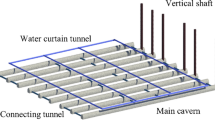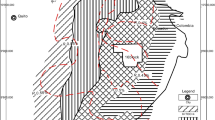Abstract
Scientific site selection is the first step in constructing underground water-sealed petroleum storage depots, but no uniform standard and code for such activity has been established. Therefore, the main objective of this study is to propose an evaluation method for the site selection of an underground water-sealed petroleum storage depot. The first large underground water-sealed petroleum storage depot being built in China served as the background of this study. The following 12 indexes were used as evaluation factors based on comprehensive evaluation criteria and specifications for key project site selection: geographic structure development feature, topographic feature, lithostratic formation feature, crustal stress, strength of rock mass, joint development feature, hydrogeological conditions, long-term water sealing conditions, environmental/ecological vulnerability, regional stability, technical and economic conditions, and meteorological and hydrological conditions. The weight back analysis and power coefficient methods were also used to evaluate the site selected for the first underground water-sealed petroleum storage depot project. Petroleum site classification models based on the two aforementioned methods were established and used to verify the feasibility of the evaluation criteria and methods, and the evaluation results show the grade of the site selected for the underground water-sealed petroleum storage depot in Huangdao, China is good. The study results may be used as a reference for the site selection of future underground water-sealed petroleum storage depots.
Similar content being viewed by others
References
Wang X. China’s oil reserves development of examining and countermeasure analysis. Technoeconomics Manage Res, 2013, 2: 102–106
Jiang Z, Feng S, Zeng L, et al. Numerical study on variation features of water table in area of underground rock cavern for oil storage. Chinese J Geotechnical Eng, 2011, 11: 1780–1785
Shi H, Liu B. Design and seepage discharge analysis of artificial water curtains for water sealed underground petroleum storage caverns in rock. Chinese J Geotechnical Eng, 2010, 32: 130–137
Wang Z, Yan E, Lu G, et al. Statistical analysis of in-situ stress field for underground water-sealed storage cavern in Chinese mainland. Rock Soil Mech, 2014, 35: 251–256
Aberg B. Prevention of gas leakage from unlined reservoirs in rock. The First International Symposium on Storage in Excavated Rock Caverns, Rockstore 77. Stockholm, Sweden, 1977. 5–8
Goodall D C, Aberg B, Brekke T L. Fundamental of gas containment in unlined rock caverns. Rock Mech Rock Eng, 1988, 21: 235–258
Chung I M, Cho W C, Bae D H. Establishment of numerical model for groundwater flow (water curtain) analysis around underground caverns. J Korea Water Resour As, 1997, 30: 63–73
Chung I M, Cho W C, Heo J H. Stochastic hydraulic safety factor for gas containment in underground storage caverns. J Hydrology, 2003, 284: 77–91
Liang J, Lindblom U. Critical pressure for gas storage in unlined rock caverns. Int J Rock Mech Min Sci Geomech Abstr, 1994, 31: 377–381
Li S C, Ping Y, Wang Z C, et al. Assessments of containment and stability of underground crude oil storage caverns based on fluid-solid coupling theory for discrete medium. Chinese J Rock Mech Eng, 2012, 11: 2161–2170
Zhang B, Yang B, Jie Y X, et al. The reliability research on water-sealed conditions of underground water-sealed oil storage caverns in Guangdong Huizhou, China. Appl Mech Mater, 2012, 170: 1318–1324
Zhang Y P, Yu S, Zhu W S. Research on seepage field of underground petroleum storage caverns in fractured rock mass. Adv Mater Res, 2012, 594: 2569–2573
Yu C, Deng S C, Li H B, et al. The anisotropic seepage analysis of water-sealed underground oil storage caverns. Tunn Undergr Sp Tech, 2013, 38: 26–37
Shi H B, Liu B. Design and seepage discharge analysis of artificial water curtains for water sealed underground petroleum storage caverns in rock. Chinese J Geotechnical Eng, 2010, 1: 130–137
Jiang Z M, Feng S R, Zhao H B, et al. 3D non-steady seepage simulation of Huizhou water sealed underground caverns for oil storage. Chinese J Undergr Sp Eng, 2012, 2: 334–338+344
Yao C, Jiang Q H, Wei W, et al. The variational inequality formulation for unconfined seepage through three-dimensional dense fracture networks. Sci China Technol Sc, 2013, 56: 1241–1247
Fan H, Zheng H. MRT-LBM-based numerical simulation of seepage flow through fractal fracture networks. Sci China Technol Sc, 2013, 56: 3115–3122.
Ju Y, Zhang Q G, Yang Y M, et al. An experimental investigation on the mechanism of fluid flow through single rough fracture of rock. Sci China Technol Sc, 2013, 56: 2070–2080
Zhang Y J, Xu T, Xu Q, et al. Hydro-mechanical coupled analysis of the stability of surrounding rock mass of underground water-sealed oil storage. Appl Mech Mater, 2013, 405: 402–405
Wang C, Guo Q, Hou Y, et al. In-situ stress field and project stability of underground water-sealed oil depots. Chinese J Geotechnical Eng, 2010, 5: 698–705
Adewuyi G O, Olowu R A. Assessment of oil and grease, total petroleum hydrocarbons and some heavy metals in surface and ground water within the vicinity of NNPC oil depot in Apata. Ibadan metropolis, Nigeria. Int J Res Rev Appl Sci, 2012, 13: 166–174
Wang Z, Li S, Liang J, et al. Prediction and measurement of groundwater flow rate of underground crude oil storage caverns. Chinese J Geotechnical Eng, 2014, 36: 1490–1497
Chen X, Xu Z Y, Zhang J K. Comprehensive classification criteria and method to the building site of large water-sealed underground oil tank, J Jilin Univ, 2012, 42:177–183
Ministry of Water Resources of the People Republic of China. GB 50218-94 Standard for Engineering Classification. Beijing: China Planning Press, 1995
Wang Z C, Li S C, Xue Y G. Technical properties of surrounding rocks of large water-sealed underground oil storage caverns during construction process. Rock Soil Mech, 2013, 34: 275–283
Liu Z J, Yu X X, Li L, et al. Vulnerability assessment of eco-environment in Yimeng mountainous area of Shandong Province based on SRP conceptual model. Chinese J Appl Ecology, 2011, 22: 2084–2090
Xu J, Zhang Q, Wu J. Application of efficacy coefficient method to determination of rock preferred structural plane. J Hohai Univ, 2008, 4: 538–541
Qiu D G, Zhang L W, Li S C, et al. Weighted distance discriminant method based on weight back analysis method and its application. Rock Soil Mech, 2010, 31: 3244–3247
Coello C A. Evolutionary multi-objective optimization: Some current research trends and topics that remain to be explored. Front Comput Sci-Chi, 2009, 3: 18–30
Cai W. Extension theory and its application. Chin Sci Bull, 1999, 44: 1538–1548
Wang M H. Application of extension theory to vibration fault diagnosis of generator sets. Gener Transm Dis, 2004, 151: 503–508
Eberhart R C, Kennedy J. A new optimizer using particle swarm theory. In: Proceedings of the Sixth International Symposium on Micro Machine and Human Science. IEEE, 1995. 39–43
Trelea I C. The particle swarm optimization algorithm: Convergence analysis and parameter selection. Inform Proce Lett, 2003, 85: 317–325
Author information
Authors and Affiliations
Corresponding author
Rights and permissions
About this article
Cite this article
Xue, Y., Li, S., Qiu, D. et al. A new evaluation method for site selection of large underground water-sealed petroleum storage depots. Sci. China Technol. Sci. 58, 967–978 (2015). https://doi.org/10.1007/s11431-015-5825-0
Received:
Accepted:
Published:
Issue Date:
DOI: https://doi.org/10.1007/s11431-015-5825-0




